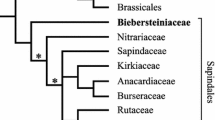Abstract.
Because of their basal phylogenetic position, Amborella, Nymphaeales, and Illiciales (and allies) are key to reconstructing ancestral character states and to tracing character state transitions that occurred during the earliest radiation of flowering plants. Endosperm is the sexually-derived embryo-nourishing tissue that is unique to the life cycle of angiosperms. We provide detailed descriptions of endosperm development in Amborella, Nuphar (Nymphaeales), and Illicium (Illiciales) and compare patterns within an explicit phylogenetic context for the three basal lineages that they represent. Amborella and Illicium share a bipolar, cellular pattern of development, characterized by an oblique first division, that was resolved as ancestral for flowering plants. A series of character state transformations occurred within Nymphaeales which led first to a modified cellular pattern with a transverse first division (present in Nuphar). The transverse cellular pattern was transformed to a helobial pattern that is present in Cabombaceae. Endosperm ontogeny involves dissociable elements and appears to fit the model of a modular developmental process.
Similar content being viewed by others
Author information
Authors and Affiliations
Additional information
Received January 19, 2001 Accepted March 19, 2001
Rights and permissions
About this article
Cite this article
Floyd, S., Friedman, W. Developmental evolution of endosperm in basal angiosperms: evidence from Amborella (Amborellaceae), Nuphar (Nymphaeaceae), and Illicium (Illiciaceae). Plant Syst. Evol. 228, 153–169 (2001). https://doi.org/10.1007/s006060170026
Issue Date:
DOI: https://doi.org/10.1007/s006060170026




